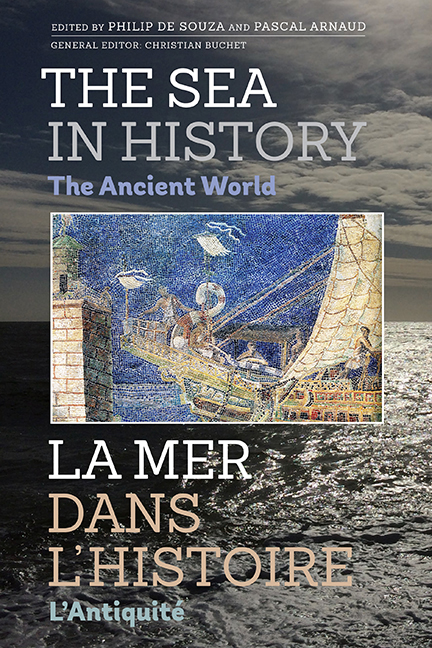Book contents
- Frontmatter
- Contents
- List of Illustrations
- List of Contributors
- Introduction générale et remerciements par Christian Buchet
- General introduction and acknowledgements
- Introduction (français)
- Introduction (English)
- La mer est le propre d'Homo sapiens
- PREHISTORICAL CASE STUDIES
- HISTORIAL CASE STUDIES: The Ancient Near East and Pharaonic Egypt
- Watercraft at the beginning of history: the case of third-millennium Southern Mesopotamia
- La navigation fluviale sur l'Euphrate au second millénaire av. J.-C.: usages, enjeux et communautés de pratiques
- The development of maritime exchange in the Bronze Age Eastern Mediterranean
- Development of maritime trade in the Egyptian world during the Late Age
- Les peuples de la mer
- Un événement nautique de la XXVIe dynastie: le voyage de la future divine adoratrice Nitocris de Saïs à Thèbes sous le règne de Psammétique Ier en 655 av. J.-C.
- HISTORICAL CASE STUDIES: The Mediterranean world
- HISTORICAL CASE STUDIES: The Indian Ocean and the Far East
- Conclusion (français)
- Conclusion (English)
- Conclusion générale par Christian Buchet
- General conclusion
- Comprendre le rôle de la mer dans L'histoire pour éclairer notre avenir
- Understanding the role the sea has played in our past in order to shed light on our future!
The development of maritime exchange in the Bronze Age Eastern Mediterranean
from HISTORIAL CASE STUDIES: The Ancient Near East and Pharaonic Egypt
Published online by Cambridge University Press: 20 April 2017
- Frontmatter
- Contents
- List of Illustrations
- List of Contributors
- Introduction générale et remerciements par Christian Buchet
- General introduction and acknowledgements
- Introduction (français)
- Introduction (English)
- La mer est le propre d'Homo sapiens
- PREHISTORICAL CASE STUDIES
- HISTORIAL CASE STUDIES: The Ancient Near East and Pharaonic Egypt
- Watercraft at the beginning of history: the case of third-millennium Southern Mesopotamia
- La navigation fluviale sur l'Euphrate au second millénaire av. J.-C.: usages, enjeux et communautés de pratiques
- The development of maritime exchange in the Bronze Age Eastern Mediterranean
- Development of maritime trade in the Egyptian world during the Late Age
- Les peuples de la mer
- Un événement nautique de la XXVIe dynastie: le voyage de la future divine adoratrice Nitocris de Saïs à Thèbes sous le règne de Psammétique Ier en 655 av. J.-C.
- HISTORICAL CASE STUDIES: The Mediterranean world
- HISTORICAL CASE STUDIES: The Indian Ocean and the Far East
- Conclusion (français)
- Conclusion (English)
- Conclusion générale par Christian Buchet
- General conclusion
- Comprendre le rôle de la mer dans L'histoire pour éclairer notre avenir
- Understanding the role the sea has played in our past in order to shed light on our future!
Summary
ABSTRACT.This contribution examines the extensive international maritime exchange networks that developed in the Eastern Mediterranean during the late Bronze Age (1550–1180 BC). It shows how the details of these networks that are indicated by surviving textual sources, including documents from the archives of Egyptian, Hittite, Ugaritic and Babylonian rulers, can be supplemented by an ever-increasing body of archaeological evidence to reveal a wide range of raw materials, trade goods and luxury items being shipped between the élites of the Eastern Mediterranean in this period.
RÉSUMÉ.Cette contribution étudie les vastes réseaux internationaux d’échange maritime qui se sont développés en Méditerranée orientale vers la fin de l’Âge du bronze (1550–1180 av. J.-C.). En s'appuyant sur des sources textuelles d'origine, et notamment des documents issus des archives des souverains égyptiens, hittites, ougaritiques et babyloniens, et en les comparant à l'ensemble de plus en plus fourni de preuves archéologiques, elle révèle le vaste éventail de matières premières, de marchandises et de produits de luxe qui transitaient par bateau entre les élites de Méditerranée orientale à cette période.
During the Bronze Age (c. 3200–1180 BC) a growth in long-distance exchanges is visible in the Eastern Mediterranean, picking up in the Late Bronze Age (c. 1550– 1180 BC), which is generally described as an international period. International networks linking the Levant, the Aegean and Egypt are documented since at least the Middle Bronze Age, by Aegean type paintings in the Levant (at Alalakh, Qatna and Tell Kabri) and in Egypt (at Tell el Daba). Moreover, a text from Mari demonstrates that, in the coastal region of the Levant, the city state of Ugarit was already an active trading hub where tin trade was conducted with Minoans, with the help of a translator.1 During the Late Bronze Age, the intensification of exchange is documented by archaeological material itself as well as by ancient texts, be they private or official letters, administrative documents or tales and stories.
- Type
- Chapter
- Information
- The Sea in History - The Ancient World , pp. 151 - 164Publisher: Boydell & BrewerPrint publication year: 2017
- 2
- Cited by

